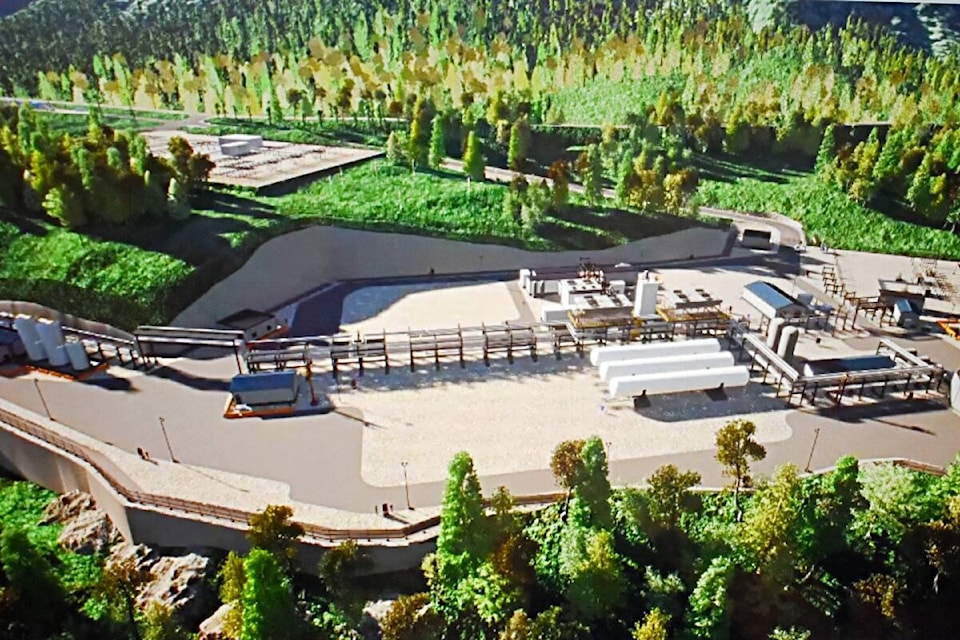A small-scale liquefied natural gas facility planned at Port Edward is the latest project to offer the potential for rate relief for existing customers of Pacific Northern Gas (PNG).
The utility’s customers west of Vanderhoof to the coast have for years endured the highest gas delivery rates in the province because PNG lost a series of large industrial customers — and their revenue — over time.
Two pulp mill closures, one in Kitimat and the other near Port Edward, and the decision by chemical giant Methanex to shutter its natural gas-using, methanol-producing plant in Kitimat increasingly left PNG’s existing residential, small business and commercial customers paying the full cost of maintaining the utility’s largely empty pipeline.
But now, privately-held Port Edward LNG wants to build a small feeder line from PNG’s line to a planned facility to super cool 150,000 tonnes of natural gas a year.
The project now has regulatory approval from the BC Utilities Commission and has met permit conditions laid down by the BC Oil and Gas Commission.
And while there’s been a delay in site preparation and putting construction boots on the ground, Port Edward LNG has advanced enough that its first payments to PNG are to start this December.
It’s encouraging news for PNG’s existing customers in that the money from Port Edward LNG will help pay to maintain and improve the utility’s line.
It also fits the past narrative associated with earlier but failed proposals to take up the utility’s pipe capacity.
Under a previous owner, Calgary-based AltaGas, PNG was heavily involved in the middle of the past decade in Douglas Channel LNG which would have been a floating terminal moored near Kitimat. It would have been fed via a spur line branching off of the utility’s line into Kitimat.
“PNG customers who live and work in northwestern BC can expect to benefit from lower natural gas rates,” said David Harris, the AltaGas president in 2015, of the potential then for Douglas Channel LNG.
That project was shelved barely a year later when AltaGas and customers could not sign up enough customers.
This time PNG is saying that rate relief might not be an actual reduction in what customers pay now for delivery but instead lower what might be higher increases in the years ahead.
That’s because its line and infrastructure through the northwest is aging and needs modernization.
“There’s significant capital expenditure and pressure on the rates,” explained Gordon Doyle, a PNG vice president.
Motorists travelling to and from Prince Rupert on Hwy 16 last year will have noticed access road signs leading to one substantial capital project — nearly $85 million is being spent over three years to replace 80 kilometres of pipe.
Doyle said it would be premature right now to state that the expected revenue from Port Edward LNG — as well as revenue from any other large-scale users that might eventually surface — would be sufficient to lower delivery rates.
“However, PNG customers will benefit from the increased system use, which will act to stablize future rates,” he said.
The contract arrangements for payments to start from Port Edward LNG are in provisions called “take or pay”.
“Port Edward LNG is required to begin its payments on December 1, 2022 whether it is ready to take service or not,” Doyle said.
The company has also provided PNG with sufficient financial guarantees that the utility is moving ahead on design and engineering, he said.
Port Edward LNG had wanted site preparation to start last year with a production start in 2023 but a delay in the BC Oil and Gas Commission providing permits pushed the timetable back.
The oil and gas commission had never examined proposals for small-scale LNG projects before and so wanted to fully understand what was involved.
“Bringing schedule alignment requires some flexibility,” said Port Edward LNG president Chris Hilliard. “Port Edward LNG has worked hard with PNG and the regulator and is confident schedules will mesh.”
Site preparation of surveys, road access and levelling ground is now scheduled for sometime in the first quarter of this year.
“Liquefaction and other large equipment orders, electrical for instance, are targeted for mid-year,” said Hilliard.
At a first phase annual production capacity of 150,000 tonnes with a potential to double that volume, putting it at approximately one per cent the size of the LNG Canada facility at Kitimat, Port Edward LNG is similar in size to what Hilliard describes as hundreds of such facilities in China.
In this instance, super-cooled natural gas will be pumped into pressurized containers and trucked to the nearby Port of Prince Rupert for export primarily to Asian customers. There’s also the possibility those containers could be shipped to domestic consumers.
“All focus on the reduction of greenhouse gas emissions and improving air quality,” Hilliard said of the equivalent Chinese facilities. “Our plant continues in that tradition of finding innovative ways to reduce our footprint.”
Discussions continue with BC Hydro to use its hydroelectricity to run the gas-cooling equipment, an additional measure Port Edward LNG is using to promote its green agenda.
There are no signed customers yet, but Hilliard says interest is strong in Asia.
“Relatively smaller LNG distributors in China see their supply curtailed through winter months every year,” he said.
“We provide a consistent annual supply at competitive prices with a wonderful green footprint.”
